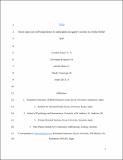Great apes use self-experience to anticipate an agent’s action in a false-belief test
Abstract
Human social life depends on theory of mind, the ability to attribute mental states to oneself and others. A signature of theory of mind, false belief understanding, requires representing others’ views of the world, even when they conflict with one’s own. After decades of research, it remains controversial whether any nonhuman species possess a theory of mind. One challenge to positive evidence of animal theory of mind, the behavior-rule account, holds that animals solve such tasks by responding to others’ behavioral cues rather than their mental states. We distinguish these hypotheses by implementing a version of the “goggles” test, which asks whether, in the absence of any additional behavioral cues, animals can use their own self-experience of a novel barrier being translucent or opaque to determine whether another agent can see through the same barrier. We incorporated this paradigm into an established anticipatory-looking false-belief test for great apes. In a between-subjects design, apes experienced a novel barrier as either translucent or opaque, although both looked identical from afar. While being eye tracked, all apes then watched a video in which an actor saw an object hidden under 1 of 2 identical boxes. The actor then scuttled behind the novel barrier, at which point the object was relocated and then removed. Only apes who experienced the barrier as opaque visually anticipated that the actor would mistakenly search for the object in its previous location. Great apes, therefore, appeared to attribute differential visual access based specifically on their own past perceptual experience to anticipate an agent’s actions in a false-belief test.
Citation
Kano , F , Krupenye , C , Hirata , S , Tomonaga , M & Call , J 2019 , ' Great apes use self-experience to anticipate an agent’s action in a false-belief test ' , Proceedings of the National Academy of Sciences of the United States of America , vol. 116 , no. 42 , pp. 20904-20909 . https://doi.org/10.1073/pnas.1910095116
Publication
Proceedings of the National Academy of Sciences of the United States of America
Status
Peer reviewed
ISSN
0027-8424Type
Journal article
Description
Financial support came from Japan Society for Promotion of Science [KAKENHI 18H05072, 19H01772, 16H06301 to FK, 18H05524 to SH, 16H06283, LDG-U04, GAIN to TM], European Commission Marie Skłodowska-Curie fellowship [MENTALIZINGORIGINS to CK], and European Research Council [Synergy grant 609819 SOMICS to JC]Collections
Items in the St Andrews Research Repository are protected by copyright, with all rights reserved, unless otherwise indicated.

